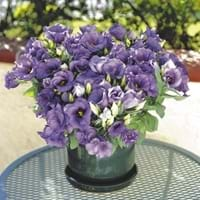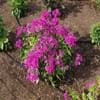Life Span
Perennial
Biennial
Type
Flowering Plants, Fruits, Trees
Flowering Plants, Grass, Herbs
Origin
Anatolia, Asia, Europe, Iran, Maghreb, Morocco, Norway, The Hiamalayas
Southwestern United States, Mexico
Types
Flowering Cherries, Sour Cherries, Sand Cherries, Sweet Cherries, Capulin Cherries
'Balboa White' lisianthus, 'Forever Blue' lisianthus, 'Forever White' lisianthus, 'Lisa Pink' lisianthus
Habitat
Forest edges, Wild, Woods
Grassland, Warmer regions
USDA Hardiness Zone
4-8
8-11
Sunset Zone
4, 5, 6, 7, 15, 16, 17
1a, 1b, 2a, 2b, 3a, 3b, 4, 5, 6, 7, 8, 9, 10, 11, 12, 13, 14, 15, 16, 17, 18, 19, 20, 21, 22, 23, 24
Habit
Upright/Erect
Upright/Erect
Minimum Height
Not Available
Minimum Width
Not Available
Flower Color
White
White, Blue, Pink, Lavender, Blue Violet
Flower Color Modifier
Not Available
Bicolor
Fruit Color
Red
Not Available
Leaf Color in Spring
Dark Green
Gray Green
Leaf Color in Summer
Orange
Gray Green
Leaf Color in Fall
Orange
Gray Green
Leaf Color in Winter
Orange
Gray Green
Leaf Shape
Oblong
Succulent
Plant Season
Spring, Summer
Spring, Summer
Sunlight
Full Sun, Partial shade
Full Sun, Partial Sun
Type of Soil
Loamy, Well drained
Clay, Loam, Sand
The pH of Soil
Slightly Acidic
Neutral, Alkaline
Soil Drainage
Average
Well drained
Bloom Time
Early Spring, Spring
Spring, Late Spring, Early Summer, Summer, Late Summer
Tolerances
Heat And Humidity, Not Available
Not Available
Where to Plant?
Ground
Container, Ground, Pot
How to Plant?
Grafting, Seedlings, Transplanting
Seedlings, Stem Planting
Plant Maintenance
Medium
Medium
Watering Requirements
Never Over-water, Over-watering can cause leaf problems or root diseases, Prefer drip-irrigation instead of Over-head watering, Water twice a day in the initial period
Form a Soil ring to water efficiently, It cannot sustain wet-feet, Keep the ground moist but not water-logged, Use Mulches to help prevent water loss during hot and windy weather, Water twice a day in the initial period
In Summer
Lots of watering
Lots of watering
In Spring
Moderate
Moderate
In Winter
Average Water
Average Water
Soil pH
Slightly Acidic
Neutral, Alkaline
Soil Type
Loamy, Well drained
Clay, Loam, Sand
Soil Drainage Capacity
Average
Well drained
Sun Exposure
Full Sun, Partial shade
Full Sun, Partial Sun
Pruning
Don't prune in the fall, Prune if you want to improve plant shape, Prune in late winter, Remove dead or diseased plant parts, Remove deadheads
Cut or pinch the stems, Prune ocassionally, Remove dead or diseased plant parts, Remove deadheads
Fertilizers
All-Purpose Liquid Fertilizer
All-Purpose Liquid Fertilizer
Pests and Diseases
Aphids, Bacterial Canker, Black Knot, Brown Rot, Caterpillars
Botrytis Blight, Cercospora leaf spot, Cucumber mosaic, Curvularia blotch, Downy mildew, Fusarium stem rot, Fusarium wilt, Impatiens necrotic spot, Lisianthus necrosis, Phyllosticta leaf spot, Pythium root rot, Rhizoctonia stem rot, Sclerophoma stem blight, Tobacco mosaic
Plant Tolerance
Drought
Drought
Flower Petal Number
Not Available
Single, Double, Semi-Double
Foliage Texture
Not Available
Medium
Foliage Sheen
Not Available
Matte
Attracts
Birds
Bees, Butterflies
Allergy
Swelling in the face
Chest tightness, Diarrhea, Dizziness, Nausea, Vomiting
Aesthetic Uses
Showy Purposes
Beautification, Bouquets, Showy Purposes, Used for decorating walls, fences, gates, hedges, etc.
Beauty Benefits
Not Available
Not Available
Environmental Uses
Air purification
Air purification
Medicinal Uses
Arthritis, Gout, Kidney problems, Rheumatoid arthritis, Swelling
Not Available
Part of Plant Used
Flowers, Fruits
Flowers
Other Uses
Wood is used for making furniture
Showy Purposes, Used for fragrance
Used As Indoor Plant
No
Yes
Used As Outdoor Plant
Yes
Yes
Garden Design
Not Available
Bedding Plant, Container, Cutflower, Mixed Border, Wildflower
Botanical Name
Prunus avium
EUSTOMA grandiflorum
Common Name
Cherry Tree
Lisianthus, Florida blue,bBuebell
In Hindi
चेरी का पेड़
Lisianthus
In German
Kirschbaum
Lisianthus
In French
Cerisier
Lisianthus
In Spanish
Cerezo
Lisianthus
In Greek
κερασιά
Lisianthus
In Portuguese
árvore de cereja
Lisianthus
In Polish
wiśniowe drzewo
Eustoma
In Latin
Cherry
Lisianthus
Phylum
Magnoliophyta
Magnoliophyta
Class
Magnoliopsida
Magnoliopsida
Order
Rosales
Gentianales
Family
Rosaceae
Gentianaceae
Clade
Angiosperms, Eudicots, Rosids
Angiosperms, Asterids, Eudicots
Tribe
Not Available
Chironieae
Subfamily
Not Available
Not Available
Number of Species
Not Available
Importance of Cherry Tree and Florida Blue
Want to have the most appropriate plant for your garden? You might want to know the importance of Cherry Tree and Florida Blue. Basically, these two plants vary in many aspects. Compare Cherry Tree and Florida Blue as they differ in many characteristics such as their life, care, benefits, facts, etc. Every gardener must at least have the slightest clue about the plants he wants to plant in his garden. Compare their benefits, which differ in many ways like facts and uses. The medicinal use of Cherry Tree is Arthritis, Gout, Kidney problems, Rheumatoid arthritis and Swelling whereas of Florida Blue is Not Available. Cherry Tree has beauty benefits as follows: Not Available while Florida Blue has beauty benefits as follows: Not Available.
Compare Facts of Cherry Tree vs Florida Blue
How to choose the best garden plant for your garden depending upon its facts? Here garden plant comparison will help you to solve this query. Compare the facts of Cherry Tree vs Florida Blue and know which one to choose. As garden plants have benefits and other uses, allergy is also a major drawback of plants for some people. Allergic reactions of Cherry Tree are Swelling in the face whereas of Florida Blue have Chest tightness, Diarrhea, Dizziness, Nausea and Vomiting respectively. Having a fruit bearing plant in your garden can be a plus point of your garden. Cherry Tree has showy fruits and Florida Blue has no showy fruits. Also Cherry Tree is flowering and Florida Blue is flowering. You can compare Cherry Tree and Florida Blue facts and facts of other plants too.





